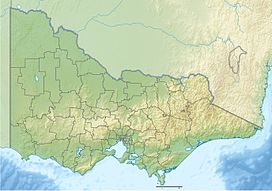Mount Wycheproof: Difference between revisions
reverted infobox change |
Rescuing orphaned refs ("Yalkowski" from rev 745519555) |
||
| Line 21: | Line 21: | ||
}} |
}} |
||
'''Mount Wycheproof''' is a hill located in the small town of [[Wycheproof, Victoria|Wycheproof]], [[Victoria (Australia)|Victoria]], [[Australia]]. Standing at {{convert|43|m|ft}} above the surrounding terrain, Mount Wycheproof has been called the smallest mountain in the world.<ref name=Yalkowski/> The township of Wycheproof is located on the hillside, and a unique geological substance known as Wycheproofite is exclusive to the local area. |
'''Mount Wycheproof''' is a hill located in the small town of [[Wycheproof, Victoria|Wycheproof]], [[Victoria (Australia)|Victoria]], [[Australia]]. Standing at {{convert|43|m|ft}} above the surrounding terrain, Mount Wycheproof has been called the smallest mountain in the world.<ref name=Yalkowski>{{cite web |url=http://www.sentex.net/~ajy/facts/geography.html|title=Interesting Facts - Geography|accessdate=20 November 2008 |publisher=James Yolkowski|date= 13 January 2008}}</ref> The township of Wycheproof is located on the hillside, and a unique geological substance known as Wycheproofite is exclusive to the local area. |
||
==History== |
==History== |
||
The township of Wycheproof is located on the hill's south western slopes<ref name=SoV>{{cite web |url=http://www.dpi.vic.gov.au/dpi/vro/vrosite.nsf/pages/landform_geomorphological_framework_4.4|title=4.4 Hills and Low Hills|accessdate=20 November 2008 |publisher=State of Victoria|date= 24 September 2008}}</ref> The settlement was started as early as 1846, but the township was not surveyed until 1875. The name 'Wycheproof' originates from the local Aboriginal language, 'wichi-poorp', meaning 'grass on a hill'.<ref name=SMH>{{cite web |url=http://www.smh.com.au/news/victoria/wycheproof/2005/02/17/1108500207659.html|title=Wycheproof - Victoria - Australia|accessdate=20 November 2008 |publisher=Sydney Morning Herald|date= 8 February 2004}}</ref> The hill plays a role in the local community, with annual races to the hilltop.<ref name=SMH/> There are many walking tracks in the area, and local wildlife such as [[emu]]s and [[kangaroos]] can be seen.<ref name = SMH/> |
The township of Wycheproof is located on the hill's south western slopes<ref name=SoV>{{cite web |url=http://www.dpi.vic.gov.au/dpi/vro/vrosite.nsf/pages/landform_geomorphological_framework_4.4|title=4.4 Hills and Low Hills|accessdate=20 November 2008 |publisher=State of Victoria|date= 24 September 2008}}</ref> The settlement was started as early as 1846, but the township was not surveyed until 1875. The name 'Wycheproof' originates from the local Aboriginal language, 'wichi-poorp', meaning 'grass on a hill'.<ref name=SMH>{{cite web |url=http://www.smh.com.au/news/victoria/wycheproof/2005/02/17/1108500207659.html|title=Wycheproof - Victoria - Australia|accessdate=20 November 2008 |publisher=Sydney Morning Herald|date= 8 February 2004}}</ref> The hill plays a role in the local community, with annual races to the hilltop.<ref name=SMH/> There are many walking tracks in the area, and local wildlife such as [[emu]]s and [[kangaroos]] can be seen.<ref name = SMH/> |
||
Revision as of 16:44, 21 October 2016
| Mount Wycheproof | |
|---|---|
 View from the Mount Wycheproof lookout | |
| Highest point | |
| Elevation | 148 metres (486 ft) AHD [1] |
| Prominence | 43 metres (141 ft) AHD |
| Geography | |
Location in Victoria | |
| Location | Wycheproof, Victoria, Australia |
| Parent range | Terrick Terrick Range |
Mount Wycheproof is a hill located in the small town of Wycheproof, Victoria, Australia. Standing at 43 metres (141 ft) above the surrounding terrain, Mount Wycheproof has been called the smallest mountain in the world.[2] The township of Wycheproof is located on the hillside, and a unique geological substance known as Wycheproofite is exclusive to the local area.
History
The township of Wycheproof is located on the hill's south western slopes[3] The settlement was started as early as 1846, but the township was not surveyed until 1875. The name 'Wycheproof' originates from the local Aboriginal language, 'wichi-poorp', meaning 'grass on a hill'.[4] The hill plays a role in the local community, with annual races to the hilltop.[4] There are many walking tracks in the area, and local wildlife such as emus and kangaroos can be seen.[4]
Geology
Mount Wycheproof is a granite outcrop, formed thousands of years ago. Located in a flat grassland area, the rounded terrain of Mount Wycheproof is consistent with that of the surrounding area.[3][5] Sharing several similarities to nearby Pyramid Hill, Mount Wycheproof is part of the low-lying Terrick Terrick range.[3] The hill rises to a height of 148 metres (486 ft)[1] above sea level or only 43 metres (141 ft) above the surrounding plains,[6] The hill is characterised by a rocky, conical peak, common in the western areas of Victoria.[3] Phosphate materials are relatively rare in Victoria,[7] yet the Wycheproof area is known to have its own unique mineral, known as Wycheproofite.[8] Wycheproofite can be characterised by its pinkish colour and its transparency.[8]
See also
References
- ^ a b St Arnaud (Map) (1st ed.). 1:250,000. Series 1501. The Royal Australian Survey Corps. 1987. § YF0105.
- ^ "Interesting Facts - Geography". James Yolkowski. 13 January 2008. Retrieved 20 November 2008.
- ^ a b c d "4.4 Hills and Low Hills". State of Victoria. 24 September 2008. Retrieved 20 November 2008.
- ^ a b c "Wycheproof - Victoria - Australia". Sydney Morning Herald. 8 February 2004. Retrieved 20 November 2008.
- ^ "Our Environment". Friends of Mount Wycheproof. Archived from the original on 18 July 2008. Retrieved 20 November 2008.
- ^ "7:30 Report - 01/11/2004". Australian Broadcasting Corporation. 1 November 2004. Retrieved 20 November 2008.
- ^ "Mineralogy and Petrology". Museum Victoria. 20 August 1996. Retrieved 20 November 2008.
- ^ a b "mineral general info". Queensland University of Technology. Retrieved 20 November 2008.

